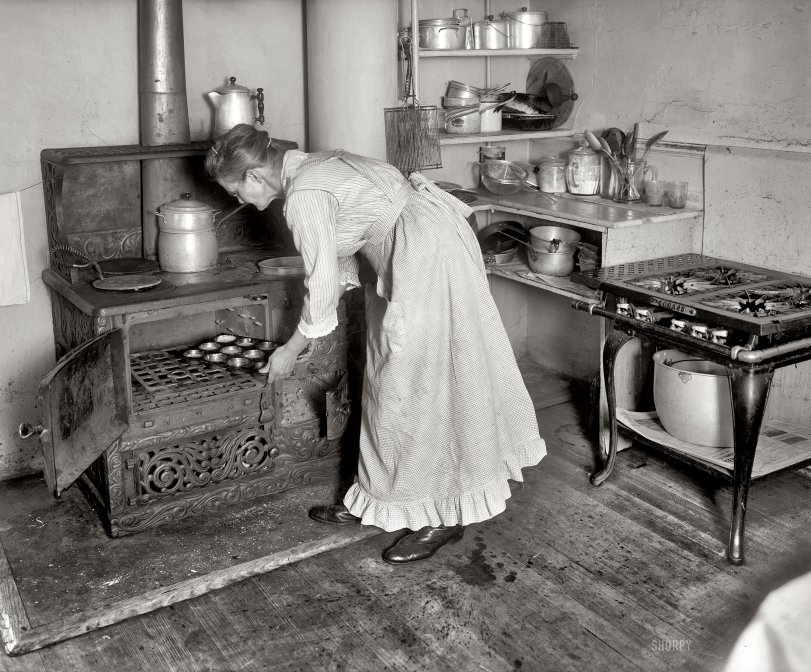


Framed or unframed, desk size to sofa size, printed by us in Arizona and Alabama since 2007. Explore now.
Shorpy is funded by you. Patreon contributors get an ad-free experience.
Learn more.

- Lost in Toyland
- And without gloves
- If I were a blindfolded time traveler
- Smoke Consumer Also Cooks
- Oh that stove!
- Possibly still there?
- What?!?
- $100 Reward
- Freeze Frame
- Texas Flyer wanted
- Just a Year Too Soon
- WWII -- Replacing men with women at the railroad crossing.
- Yes, Icing
- You kids drive me nuts!
- NOT An Easy Job
- I wonder
- Just add window boxes
- Icing Platform?
- Indiana Harbor Belt abides
- Freezing haze
- Corrections (for those who care)
- C&NW at Nelson
- Fallen Flags
- A dangerous job made worse
- Water Stop
- Passenger trains have right of way over freights?
- Coal
- Never ceases to amaze me.
- Still chuggin' (in model form)
- Great shot
Print Emporium
Granny's Kitchen: 1917

Washington, D.C., circa 1917 and Mrs. Beuchert again. Why this lady's muffin-making would have been chronicled in the archives of the National Photo Company is something of a mystery. 8x10 inch glass negative. View full size.
Oh, Please!
Wouldn't eat anything that came out of that kitchen you say, pattyanne? Great. All the more for me. Pssshaw!
Fark 20 minutes at 350F
Clean as a Whistle!
I just visited my son at university to bring him home after graduation, and having seen the condition of the kitchen he and his roommates have been using, I'd rather eat from Granny's kitchen anytime!
Under the Stove
Wood-burning stoves, especially in the kitchen, almost always had some fireproof material underneath them to protect the wood floors from ashes, coals, sparks, etc.
However, the material wasn't necessarily slate, although it was often used. Here in Texas it was commonly sheet metal, especially for poor folks. It could also be ceramic tile; granite or marble in solid pieces, tiles, or (in wealthy households) mosaic patterns; or a compressed sheet of asbestos. Our family included the proprietor of a "marble yard" a.k.a. tombstone maker, and the under-stove protective material for us was often shards of marble or granite laid in a random pattern with asbestos-cement grouting.
Who was Granny?
The 1906 edition of Boyd's Directory of the District of Columbia lists about a dozen Beucherts, including Mrs. Carl Beuchert, "baker," at 1213 11th SE. (It also lists a Wm. Beuchert, "baker," at 430 K St. NW, but Granny doesn't look like a Wm.) The Beuchert name pops up numerous places around Washington (including as a business associate of of real-estate king Oliver T. Carr), so Granny may have been a matriarch.
I still have my appetite
Actually, I think the place looks pretty clean. The floor looks stained but clean, the area around the stove inevitably has ash from the stove, but the work surfaces, the main stove top, and the gas (?) grill to the right look very clean. The only thing I would criticize would be stacking the clean pots on the right facing up instead of facing down.
Smells good
Anyone who wouldn't eat the biscuits that came out of that stove is a clean freak. What a great shot of someone who probably understood how to cook.
And yes, the oven is wonderfully ornate.
Ouch! Getting old isn't for sissies, indeed.
Granny's got some bunions straining against that tight shoe leather. Looks like she may have some trouble wiping spills off the floor, too.
Nice toaster
Nice toaster, upper shelf, far right corner. My friends in Vermont have one like this, which you put on the stove (in their case over the gas flame.) It makes wonderful toast, though you need to keep an eye on it to be sure it's not over cooking. One of the best things about it is you can spread the butter while it's still toasting and thereby achieve the dream of true hot buttered toast!
Patty Anne, you are a survivor of lots of generations who cooked for millennia in conditions far worse than this I'm sure.
Lost my appetite
I am not a clean freak, but I wouldn't eat anything that came out of that kitchen!
Kitchen archeology
These two photos have been quite helpful to us in interpreting the construction design of our kitchen, which was built in 1917.
The original floor is intact, made of these same sorts of pine boards. They were were covered with real linoleum (in a hideous gray-mustard-black-red splatter pattern) sometime in the late 1920s. Several other layers of plywood, asphalt/asbestos tile, and vinyl were also added, cutting about 4 inches from the room's height.
There is also a large rectangular section of boards that wasn't original to the room, in the spot where we guess the original stove was located because of the flue holes that remain in the ceiling plaster. Now we can see that there must have been a slate inset there, for the coal stove to safely rest upon.
























On Shorpy:
Today’s Top 5